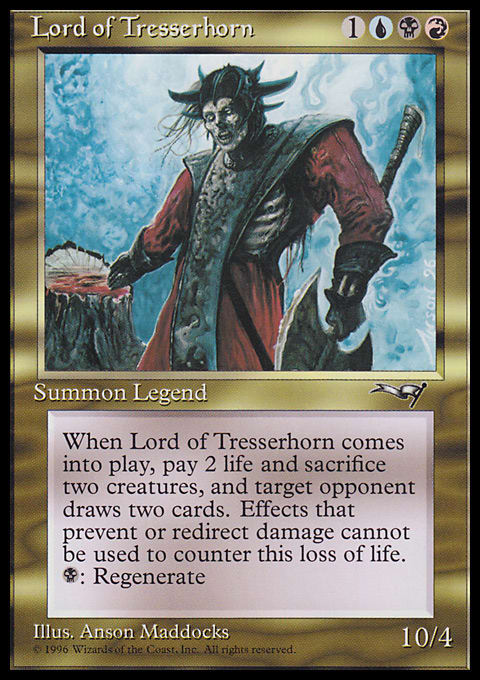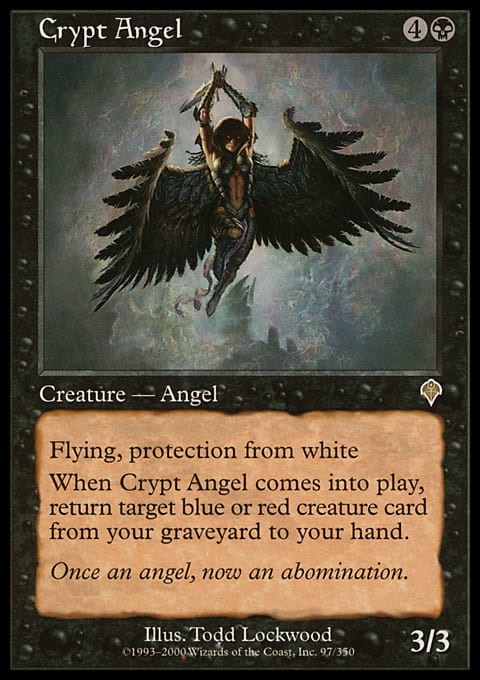When people pick up Magic: The Gathering for the first time, there's this one universal truth the majority of players face: overvaluing the power of monster-sized creatures. It's simply thinking a creature like Scaled Wurm is jaw dropping, or, by today's standards, gawking at something like Colossification. You've seen the reaction they get from a newer player. "What?! You mean I can power up this creature to be big enough that I can defeat opponents in one or two hits?!"
In practice, they never end up being as good as they seem. This is usually because there's some intense drawback or else they lack the evasion to make what you're doing worthwhile. The ones I remember from when I was a kid were Denizen of the Deep - from the Starter 99 pack art - and the Leviathan I saw in my cousins' collection. After a year or so in the game, I ran into Skyshroud Behemoth, which seemed just bonkers for how big it was, until you realize it dies fast and has no evasion to speak of and you end up retiring it quickly.
For many players, one of the game's earliest legendaries fits into this sort of odd role. It's a high-powered creature but has a lot of tradeoffs to get you there, such as losing life, sacrificing multiple creatures, and making your opponent draw cards. Yes, I'm talking about the Alliances classic Lord of Tresserhorn, aka the Good Buddy.
Lord of Tresserhorn caught the attention of many players back in the day because, unlike most of the big creatures of the era, getting it onto the battlefield was fairly manageable. When it came to something like Polar Kraken, Deep Spawn, or the aforementioned Leviathan, there was just too much work needing to be put in to make that high power worth it. Lord of Tresserhorn still asked a decent amount of you on his own. Giving up some of your resources while giving more to your opponents is a very real cost, but the fact that you get a monstrous creature with cheap and easy reanimation out of the package made it quite enticing. Did it ever make a splash? Not outside of casual play, really, but it was well loved and certainly had an amount of hype behind it amongst that crowd back in the day.
Today, I want to go back to those olden days a bit with a fun little PreDH deck reminiscent of the bygone era when the Good Buddy was more than a forgotten curiosity. The card has a lot more utility when it comes to Commander, as you have a little more time to build it up and can use the opponent card draw as a political move too. This gives him a lot more interesting play than you might normally expect in traditional 60-card Magic: The Gathering. Let's have a look at a list and then talk about what went into this one!
Lord of Tresserhorn | PreDH | Paige Smith
- Commander (1)
- 1 Lord of Tresserhorn
- Creatures (28)
- 1 Arcanis the Omnipotent
- 1 Archivist
- 1 Avatar of Woe
- 1 Bone Shredder
- 1 Brood of Cockroaches
- 1 Clone
- 1 Crypt Angel
- 1 Doomed Necromancer
- 1 Eron the Relentless
- 1 Faceless Butcher
- 1 Flametongue Kavu
- 1 Geth, Lord of the Vault
- 1 Hell's Caretaker
- 1 Mogg War Marshal
- 1 Mulldrifter
- 1 Nightscape Familiar
- 1 Phyrexian Infiltrator
- 1 Phyrexian Rager
- 1 Pit Spawn
- 1 Purraj of Urborg
- 1 Pyre Zombie
- 1 Royal Assassin
- 1 Sengir Autocrat
- 1 Shadowmage Infiltrator
- 1 Solemn Simulacrum
- 1 Thieving Magpie
- 1 Wonder
- 1 Wurmcoil Engine
- Instants (8)
- 1 Counterspell
- 1 Crosis's Charm
- 1 Exclude
- 1 Fact or Fiction
- 1 Frantic Search
- 1 Impulse
- 1 Starstorm
- 1 Terminate
- Sorceries (9)
- 1 Ashen Powder
- 1 Blatant Thievery
- 1 Deep Analysis
- 1 Diabolic Tutor
- 1 Earthquake
- 1 Empty the Warrens
- 1 Hammer of Bogardan
- 1 Insurrection
- 1 Syphon Mind
- Enchantments (8)
- 1 Aggravated Assault
- 1 Animate Dead
- 1 Control Magic
- 1 No Mercy
- 1 Oubliette
- 1 Oversold Cemetery
- 1 Phyrexian Arena
- 1 Rhystic Study
- Artifacts (7)
- 1 Dimir Signet
- 1 Fellwar Stone
- 1 Flying Carpet
- 1 Mind Stone
- 1 Nihil Spellbomb
- 1 Rakdos Signet
- 1 Sol Ring
- Lands (39)
- 4 Mountain
- 6 Island
- 8 Swamp
- 1 Bojuka Bog
- 1 City of Brass
- 1 Crumbling Necropolis
- 1 Darkwater Catacombs
- 1 Dimir Aqueduct
- 1 Evolving Wilds
- 1 Exotic Orchard
- 1 Faerie Conclave
- 1 Grand Coliseum
- 1 Izzet Boilerworks
- 1 Polluted Mire
- 1 Rakdos Carnarium
- 1 Reflecting Pool
- 1 Remote Isle
- 1 River of Tears
- 1 Shadowblood Ridge
- 1 Shivan Reef
- 1 Smoldering Crater
- 1 Sulfurous Springs
- 1 Terramorphic Expanse
- 1 Underground River
For this deck, I wanted to find a fun little theme. The problem is: Lord of Tresserhorn, while being a cool card with big stats, doesn't actually do a lot. It's hard to pull some solid synergies to utilize from the card itself compared to many other legendary creatures out there. This was a pretty common problem back in the day in that most of these legends just didn't do enough and often felt like vanilla creatures with a mediocre ability stapled onto them, thereby making it hard to do anything with them. Consider it a symptom of an era where spells ruled and creatures sucked.
Instead, I've opted for a general "for fun" theme in focusing on specifically retro frame cards to be used here. This ends up limiting the card pool even further than the traditional PreDH setup of New Phyrexia backward. There's still a lot of solid cards to pull from, but let's face it, it's really tough for a deck made up of cards from the game's first 10 years with (almost) its first 20 combined. That compounds further when you take such a list out of PreDH and try running it into a local playgroup of modern day players.
Thankfully, there's actually a touch of wiggle room with the approach here. Because it's still following PreDH legality, it just so happens that a number of cards first printed in sets between and including Mirrodin and New Phyrexia actually have retro frame printings. Many of these showed up in the likes of Time Spiral Remastered, Brothers' War Retro Frame Artifacts, and Dominaria Remastered. There's even a handful of judge foils that open the doors a bit more too, though I'm avoiding these due to availability concerns.
These extra sets open the doors to a few additional powerful cards to be put into the deck that otherwise might not be able to show up. Some solid examples here include the likes of Mulldrifter or Solemn Simulacrum for some solid utility. On the end of sheer brute force, there's Wurmcoil Engine and Geth, Lord of the Vault. It even adds in a few helpful lands, such as Crumbling Necropolis, Bojuka Bog, and the pair of Evolving Wilds and Terramorphic Expanse. I even left out some notable cards like Shriekmaw, Ponder, and Preordain that all could've fit in here smoothly. None of these cards feels terribly egregious and still keeps the aesthetic vibe thanks to those gorgeous retro card frames.
Most other cards in the list are again more going for a vibe than a cohesive strategy. This leads to the actual deck looking and feeling a bit like a pile. That's by design. I tried to invoke here some of the energy that I had when I was a kid putting together decks in the late 90s and early 00s: massive decks stuffed to the brim with what I thought were the coolest and strongest cards of the era. It really shows the more you look at it too.
Some of the cards here are pretty plainly powerful. Insurrection ends games, Avatar of Woe picks off creatures left and right, and the likes of both Rhystic Study and Phyrexian Arena give you good consistent card advantage. These are the cards where you open a few packs, realize you hit a money rare or two, and stuff them into your decks without understanding the context of why they're good and instead knowing they're good. Here, it works, and they just end up being the good powerhouses you'd come to expect in a typical Commander decklist. Hell, most of them are still generically good to this day.
Then you start really looking through the build and you start to see some real weirdos. For example, Flying Carpet sticks out like a sore thumb. Your first instinct is to go "why on earth is this here?" Spoiler: it's to give your commander evasion. You get a similar reaction with other traditional stinkers like Sengir Autocrat or Crypt Angel. They're weird oddball cards most players wouldn't look at twice. When was the last time you saw someone play a Pyre Zombie outside Dominaria Remastered Limited? How about Phyrexian Infiltrator? Pit Spawn? They're just the kind of fun cards that can only come out of decks made out of "cards I own" strategies without in-depth front-to-back optimization.
Many of these were indeed the cards I owned and played with quite a bit as a kid. Even ones I didn't, such as Pit Spawn, friends ended up wrecking me with. By today's standards, they just can't compare in many circumstances, but they do just the right amount of good things to be fun to throw down in a game of Commander. The main idea here, after all, is to evoke those classic casual gameplay vibes of Magic: The Gathering in the 90s and I like to think that I've succeeded on that front. The deck's not even that expensive compared to most Commander lists out there and can be had for only about $160 - with many of these cards likely sitting in your bulk bins as is.
In a world where optimization and spaces like EDHREC.com are king, it's sometimes easy to forget just how much fun it can be to riffle through some boxes and binders and toss together some solid jank. Some of the most fun I've had playing the format in years has been taking that very approach and I can't recommend it highly enough. For something like this, I've no doubt you'll find plenty of ways to enjoy it if you build the list and take it to your next Commander night. I imagine it'll surprise everyone at the table, including yourself! Take it for a spin and have a great time, Good Buddy!
Paige Smith
Twitter: @TheMaverickGal
Twitch: twitch.tv/themaverickgirl
YouTube: TheMaverickGal



























